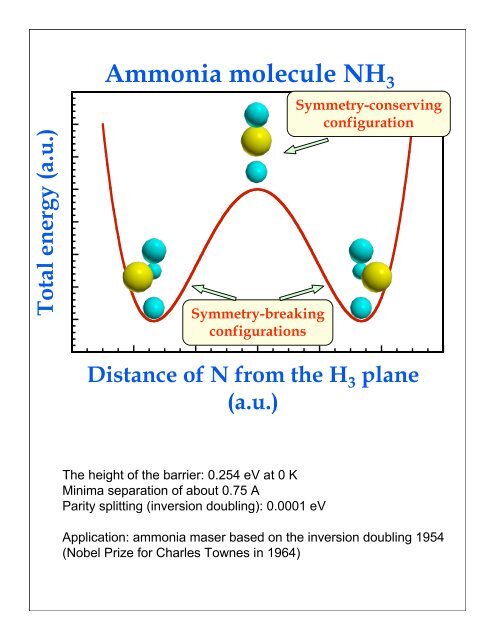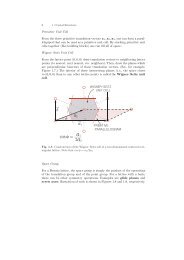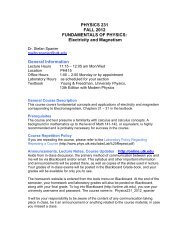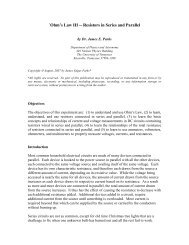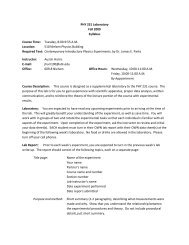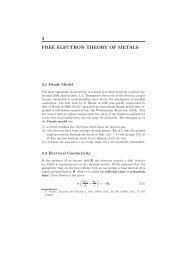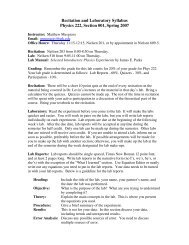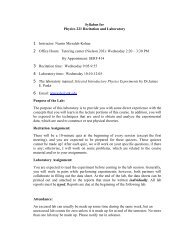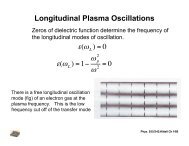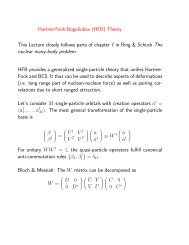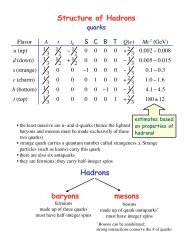Hartree-Fock equations. Spontaneous symmetry breaking
Hartree-Fock equations. Spontaneous symmetry breaking
Hartree-Fock equations. Spontaneous symmetry breaking
You also want an ePaper? Increase the reach of your titles
YUMPU automatically turns print PDFs into web optimized ePapers that Google loves.
Ammonia molecule NH 3<br />
Total energy (a.u.)<br />
Symmetry-<strong>breaking</strong><br />
configurations<br />
Symmetry-conserving<br />
configuration<br />
Distance of N from the H 3 plane<br />
(a.u.)<br />
The height of the barrier: 0.254 eV at 0 K<br />
Minima separation of about 0.75 A<br />
Parity splitting (inversion doubling): 0.0001 eV<br />
Application: ammonia maser based on the inversion doubling 1954<br />
(Nobel Prize for Charles Townes in 1964)
Laboratory frame and intrinsic frame<br />
(ammonia molecule)<br />
H<br />
H<br />
H<br />
|R› = |L› =<br />
" #<br />
r<br />
D " #<br />
= 0<br />
N<br />
)<br />
P L = R " #<br />
= 1 2 1+ # P<br />
)<br />
but<br />
( ) L<br />
L r<br />
D L " 0<br />
!<br />
<strong>Spontaneous</strong> <strong>symmetry</strong> <strong>breaking</strong> gives a description of the system in<br />
terms of wave packets instead of eigenstates. The wave packets<br />
corresponds to given configurations of constituents. If the<br />
configuration interaction energy is very small, the wave packets live<br />
!<br />
a very long time and behave like classical objects. If configurations<br />
are orthogonal and degenerate, the wave packets are also eigenstates<br />
(infinite systems).<br />
Symmetry restoration amounts to projecting states with good<br />
quantum numbers from the <strong>symmetry</strong>-<strong>breaking</strong> states. If the<br />
configuration interaction energy is very small, the energies of<br />
projected states are very close to those of the <strong>symmetry</strong>-<strong>breaking</strong><br />
states. Symmetry restoration can be essential for calculating average<br />
values of <strong>symmetry</strong>-conserving observables other than the<br />
Hamiltonian. After the <strong>symmetry</strong> restoration, the <strong>symmetry</strong>-<strong>breaking</strong><br />
solutions do not break <strong>symmetry</strong>!
Don’t let yourself confuse by<br />
the confusing traditional<br />
terminology<br />
When you hear about:<br />
Think about:<br />
State in the intrinsic<br />
reference frame<br />
State before the<br />
<strong>symmetry</strong> restoration<br />
State in the laboratory<br />
reference frame<br />
State after the<br />
<strong>symmetry</strong> restoration<br />
Mexican-hat potential
Intrinsic symmetries<br />
5 - ν=1<br />
3 -<br />
1 -<br />
(parallel band)<br />
D •h (C 2 , P)<br />
O<br />
C<br />
O<br />
6 +<br />
4 +<br />
2 +<br />
0 +<br />
ν=0<br />
(ground band)<br />
CO 2<br />
- an axially symmetric molecule with no static dipole moment.<br />
O<br />
C<br />
O<br />
C •ν (S=C 2 P)<br />
3 -<br />
2 +<br />
O N<br />
4 +<br />
1 -<br />
0 +<br />
N 2<br />
O - an axially symmetric molecule with static dipole moment.
Symmetry <strong>breaking</strong><br />
q = !<br />
= 0 but<br />
0 0 0<br />
Q ˆ<br />
! crit<br />
E<br />
ω RPA<br />
=0<br />
ω RPA<br />
>0 ω RPA<br />
-<br />
imag.<br />
Vibrator<br />
(weak<br />
coupling)<br />
Soft<br />
(interm.<br />
coupling)<br />
Rotor<br />
(strong<br />
coupling)<br />
No phase<br />
Band structures<br />
transition<br />
labelled by<br />
in the finite<br />
different q.n.<br />
system!<br />
[ H ˆ S ˆ ] h ˆ , S ˆ<br />
deformed<br />
intrinsic<br />
system!<br />
Q 2 !<br />
“exact”<br />
mean field<br />
of the internally<br />
broken symmetries<br />
[ ] ! 0
Laboratory frame and intrinsic frame<br />
(molecular or nuclear quadrupole moment)<br />
Q =<br />
2K 2 -I(I+1)<br />
Q<br />
(I+1)(2I+3) 0<br />
MEASURED<br />
INTRINSIC<br />
RELATIVE<br />
MOTION<br />
Q=0 for I=K=0, independently of Q 0 !
Excitation spectrum of N 2 molecule<br />
excited 1 +<br />
Σ u<br />
and 1 Π u<br />
states<br />
Rotational Transitions ~ 10 meV<br />
Vibrational Transitions ~ 100 meV<br />
Electronic Transitions ~ 1 eV<br />
r<br />
N<br />
N<br />
Diabatic potential energy<br />
surfaces for excited electronic<br />
configurations of N 2
Nuclear collective motion<br />
Rotational Transitions ~ 0.2-2 MeV<br />
Vibrational Transitions ~ 0.5-12 MeV<br />
Nucleonic Transitions ~ 7 MeV


